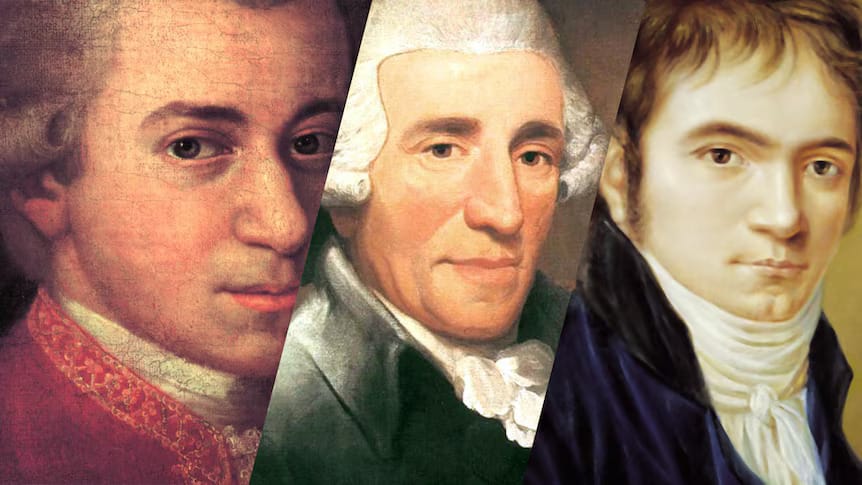The string quartet, a genre synonymous with intellectual depth and refined musical dialogue, reached an extraordinary zenith during the late 18th and early 19th centuries. At the heart of this evolution were three towering composers: Joseph Haydn, Wolfgang Amadeus Mozart, and Ludwig van Beethoven. Their contributions elevated the quartet from a modest ensemble to a sophisticated art form, one that would come to define the very essence of chamber music. This article explores how each of these composers revolutionised the string quartet, leaving an indelible mark on musical history.
Joseph Haydn: The Father of the String Quartet
Joseph Haydn (1732–1809) is often credited with establishing the modern string quartet. Though not the first to write for the ensemble of two violins, viola, and cello, he was undoubtedly the composer who standardised and perfected its structure.
In his early quartets, composed in the 1750s and 1760s, Haydn experimented with form and texture, treating the quartet as an extension of the Baroque trio sonata. However, it was in his Opus 20 quartets (1772) that he introduced a newfound balance among the four instruments, allowing them to engage in true musical conversation rather than relegating the viola and cello to a mere accompaniment role.
Haydn’s later quartets, such as Op. 33 (1781) and Op. 76 (1797), showcase remarkable ingenuity. The Op. 33 quartets, subtitled “Gli scherzi,” replaced the traditional minuet with a livelier scherzo, a transformation that influenced later composers. His Op. 76 quartets, particularly the “Emperor” Quartet, exhibit a masterful blend of lyricism and complexity, cementing his status as the father of the string quartet.
Beyond their structural innovations, Haydn’s quartets also played a crucial role in the social fabric of 18th-century musical life. Unlike the grand orchestral symphonies, quartets were primarily performed in intimate settings, reflecting a culture of refined musical discourse among aristocrats and intellectuals. This setting encouraged close listening and a deep appreciation for musical dialogue, characteristics that would shape the very essence of chamber music.
Wolfgang Amadeus Mozart: Refining the Form
Mozart (1756–1791) built upon Haydn’s innovations, refining the quartet’s expressive capabilities and harmonic richness. His early quartets, composed in the 1770s, reveal his admiration for Haydn, but it was in the six “Haydn” Quartets (1782–1785) that Mozart truly pushed the boundaries of the genre.
Mozart’s quartets are characterised by their lyrical beauty, contrapuntal sophistication, and profound emotional depth. The “Dissonance” Quartet (K. 465) is particularly noteworthy for its daring harmonic ambiguity in the introduction, a striking feature for the time. Likewise, the “Hoffmeister” Quartet (K. 499) and the three “Prussian” Quartets (K. 575, K. 589, K. 590) demonstrate Mozart’s ability to blend technical brilliance with expressive nuance.
Mozart’s quartets also feature an elevated role for the viola, an instrument he played himself. This is particularly evident in the “Hunt” Quartet (K. 458), where the viola engages in intricate interplay with the first violin, showcasing his commitment to making each instrument an equal participant in the ensemble.
Another defining aspect of Mozart’s quartets is their attention to thematic development and motivic unity. His quartets often exhibit seamless transitions between movements, a technique that would become even more pronounced in Beethoven’s later works. Mozart’s ability to create cohesion across movements helped elevate the quartet from a mere collection of contrasting sections into a unified musical statement.
Ludwig van Beethoven: Pushing the Boundaries
If Haydn laid the foundation and Mozart refined the form, Beethoven (1770–1827) shattered conventions and redefined the quartet’s artistic potential. His 16 quartets, divided into early, middle, and late periods, chart an extraordinary journey from classical clarity to unparalleled innovation.
Beethoven’s early quartets (Op. 18), composed in the late 1790s, show a deep reverence for Haydn and Mozart. However, by the middle period, his quartets took on a bolder, more dramatic character. The three “Razumovsky” Quartets (Op. 59) are particularly groundbreaking, featuring expanded structures, rich thematic development, and Russian folk melodies woven into the fabric of the music.
The late quartets (Op. 127, Op. 130, Op. 131, Op. 132, Op. 135) are among the most profound compositions in Western music. They defy traditional forms, exploring new harmonic landscapes and unconventional movements. The Große Fuge (Op. 133), originally intended as the finale of Op. 130, is a radical fugue that astounded contemporaries with its complexity and intensity. Beethoven’s Op. 131, a continuous seven-movement work, is particularly remarkable for its structural cohesion and emotional depth, influencing composers from Schubert to Bartók.
Beethoven’s quartets also introduced new technical challenges for performers, demanding unprecedented levels of virtuosity. His use of unconventional bowing techniques, intricate polyphony, and extreme dynamic contrasts forced musicians to rethink traditional quartet playing. These innovations not only expanded the expressive range of the string quartet but also set new standards for instrumental technique.
The Lasting Influence of the Classical Masters
The contributions of Haydn, Mozart, and Beethoven transformed the string quartet from a light-hearted diversion into a medium for deep artistic expression. Their works remain a cornerstone of the chamber music repertoire, continuously inspiring composers, performers, and audiences alike. Haydn’s innovation in form, Mozart’s refinement of expression, and Beethoven’s daring expansion of boundaries laid the groundwork for future composers. Schubert, Mendelssohn, Brahms, and later 20th-century masters like Bartók and Shostakovich all drew upon the quartet as a means of exploring profound musical ideas. The golden age of the string quartet, ushered in by these three masters, remains a defining chapter in classical music history. Their compositions continue to captivate listeners, demonstrating that within four string instruments lies an infinite world of musical possibility.
Source:https://serenademagazine.com/how-haydn-mozart-and-beethoven-transformed-chamber-music/

